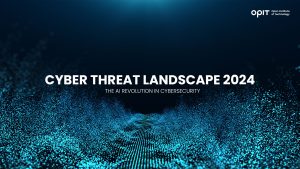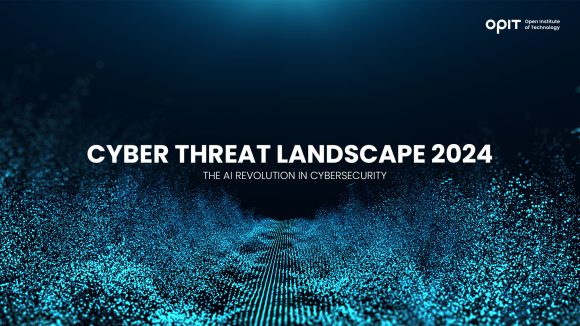

There’s no doubt about it – artificial intelligence has revolutionized almost every aspect of modern life. Healthcare, finance, and manufacturing are just some of the sectors that have been virtually turned upside down by this powerful new force. Cybersecurity also ranks high on this list.
But as much as AI can benefit cybersecurity, it also presents new challenges. Or – to be more direct –new threats.
To understand just how serious these threats are, we’ve enlisted the help of two prominent figures in the cybersecurity world – Tom Vazdar and Venicia Solomons. Tom is the chair of the Master’s Degree in Enterprise Cybersecurity program at the Open Institute of Technology (OPIT). Venicia, better known as the “Cyber Queen,” runs a widely successful cybersecurity community looking to empower women to succeed in the industry.
Together, they held a master class titled “Cyber Threat Landscape 2024: Navigating New Risks.” In this article, you get the chance to hear all about the double-edged sword that is AI in cybersecurity.
How Can Organizations Benefit From Using AI in Cybersecurity?
As with any new invention, AI has primarily been developed to benefit people. In the case of AI, this mainly refers to enhancing efficiency, accuracy, and automation in tasks that would be challenging or impossible for people to perform alone.
However, as AI technology evolves, its potential for both positive and negative impacts becomes more apparent.
But just because the ugly side of AI has started to rear its head more dramatically, it doesn’t mean we should abandon the technology altogether. The key, according to Venicia, is in finding a balance. And according to Tom, this balance lies in treating AI the same way you would cybersecurity in general.
Keep reading to learn what this means.
Top of Form
Implement a Governance Framework
In cybersecurity, there is a governance framework called ISO/IEC 27000, whose goal is to provide a systematic approach to managing sensitive company information, ensuring it remains secure. A similar framework has recently been created for AI— ISO/IEC 42001.
Now, the trouble lies in the fact that many organizations “don’t even have cybersecurity, not to speak artificial intelligence,” as Tom puts it. But the truth is that they need both if they want to have a chance at managing the risks and complexities associated with AI technology, thus only reaping its benefits.
Implement an Oversight Mechanism
Fearing the risks of AI in cybersecurity, many organizations chose to forbid the usage of this technology outright within their operations. But by doing so, they also miss out on the significant benefits AI can offer in enhancing cybersecurity defenses.
So, an all-out ban on AI isn’t a solution. A well-thought-out oversight mechanism is.
According to Tom, this control framework should dictate how and when an organization uses cybersecurity and AI and when these two fields are to come in contact. It should also answer the questions of how an organization governs AI and ensures transparency.
With both of these frameworks (governance and oversight), it’s not enough to simply implement new mechanisms. Employees should also be educated and regularly trained to uphold the principles outlined in these frameworks.
Control the AI (Not the Other Way Around!)
When it comes to relying on AI, one principle should be every organization’s guiding light. Control the AI; don’t let the AI control you.
Of course, this includes controlling how the company’s employees use AI when interacting with client data, business secrets, and other sensitive information.
Now, the thing is – people don’t like to be controlled.
But without control, things can go off the rails pretty quickly.
Tom gives just one example of this. In 2022, an improperly trained (and controlled) chatbot gave an Air Canada customer inaccurate information and a non-existing discount. As a result, the customer bought a full-price ticket. A lawsuit ensued, and in 2024, the court ruled in the customer’s favor, ordering Air Canada to pay compensation.
This case alone illustrates one thing perfectly – you must have your AI systems under control. Tom hypothesizes that the system was probably affordable and easy to implement, but it eventually cost Air Canada dearly in terms of financial and reputational damage.
How Can Organizations Protect Themselves Against AI-Driven Cyberthreats?
With well-thought-out measures in place, organizations can reap the full benefits of AI in cybersecurity without worrying about the threats. But this doesn’t make the threats disappear. Even worse, these threats are only going to get better at outsmarting the organization’s defenses.
So, what can the organizations do about these threats?
Here’s what Tom and Venicia suggest.
Fight Fire With Fire
So, AI is potentially attacking your organization’s security systems? If so, use AI to defend them. Implement your own AI-enhanced threat detection systems.
But beware – this isn’t a one-and-done solution. Tom emphasizes the importance of staying current with the latest cybersecurity threats. More importantly – make sure your systems are up to date with them.
Also, never rely on a single control system. According to our experts, “layered security measures” are the way to go.
Never Stop Learning (and Training)
When it comes to AI in cybersecurity, continuous learning and training are of utmost importance – learning for your employees and training for the AI models. It’s the only way to ensure all system aspects function properly and your employees know how to use each and every one of them.
This approach should also alleviate one of the biggest concerns regarding an increasing AI implementation. Namely, employees fear that they will lose their jobs due to AI. But the truth is, the AI systems need them just as much as they need those systems.
As Tom puts it, “You need to train the AI system so it can protect you.”
That’s why studying to be a cybersecurity professional is a smart career move.
However, you’ll want to find a program that understands the importance of AI in cybersecurity and equips you to handle it properly. Get a master’s degree in Enterprise Security from OPIT, and that’s exactly what you’ll get.
Join the Bigger Fight
When it comes to cybersecurity, transparency is key. If organizations fail to report cybersecurity incidents promptly and accurately, they not only jeopardize their own security but also that of other organizations and individuals. Transparency builds trust and allows for collaboration in addressing cybersecurity threats collectively.
So, our experts urge you to engage in information sharing and collaborative efforts with other organizations, industry groups, and governmental bodies to stay ahead of threats.
How Has AI Impacted Data Protection and Privacy?
Among the challenges presented by AI, one stands out the most – the potential impact on data privacy and protection. Why? Because there’s a growing fear that personal data might be used to train large AI models.
That’s why European policymakers sprang into action and introduced the Artificial Intelligence Act in March 2024.
This regulation, implemented by the European Parliament, aims to protect fundamental rights, democracy, the rule of law, and environmental sustainability from high-risk AI. The act is akin to the well-known General Data Protection Regulation (GDPR) passed in 2016 but exclusively targets the use of AI. The good news for those fearful of AI’s potential negative impact is that every requirement imposed by this act is backed up with heavy penalties.
But how can organizations ensure customers, clients, and partners that their data is fully protected?
According to our experts, the answer is simple – transparency, transparency, and some more transparency!
Any employed AI system must be designed in a way that doesn’t jeopardize anyone’s privacy and freedom. However, it’s not enough to just design the system in such a way. You must also ensure all the stakeholders understand this design and the system’s operation. This includes providing clear information about the data being collected, how it’s being used, and the measures in place to protect it.
Beyond their immediate group of stakeholders, organizations also must ensure that their data isn’t manipulated or used against people. Tom gives an example of what must be avoided at all costs. Let’s say a client applies for a loan in a financial institution. Under no circumstances should that institution use AI to track the client’s personal data and use it against them, resulting in a loan ban. This hypothetical scenario is a clear violation of privacy and trust.
And according to Tom, “privacy is more important than ever.” The same goes for internal ethical standards organizations must develop.
Keeping Up With Cybersecurity
Like most revolutions, AI has come in fast and left many people (and organizations) scrambling to keep up. However, those who recognize that AI isn’t going anywhere have taken steps to embrace it and fully benefit from it. They see AI for what it truly is – a fundamental shift in how we approach technology and cybersecurity.
Those individuals have also chosen to advance their knowledge in the field by completing highly specialized and comprehensive programs like OPIT’s Enterprise Cybersecurity Master’s program. Coincidentally, this is also the program where you get to hear more valuable insights from Tom Vazdar, as he has essentially developed this course.
Have questions?
Visit our FAQ page or get in touch with us!
Write us at +39 335 576 0263
Get in touch at hello@opit.com
Talk to one of our Study Advisors
We are international
We can speak in:




